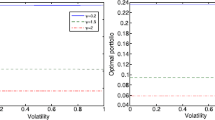Abstract
In this chapter we study the consumption behavior of an agent in the dynamic framework of consumption/investment decision making that allows the presence of a subsistence consumption level and the possibility of bankruptcy. The agent’s consumption utility is assumed to be represented by a strictly increasing, strictly concave, continuously differentiable function in the general case and by a HARA-type function in the special case treated in the chapter. It is known that the optimal consumption increases with wealth. Here we show that in general the optimal consumption is a nondecreasing function of the bankruptcy value. In the HARA case we obtain a nearly explicit characterization of the consumption behavior.
Access this chapter
Tax calculation will be finalised at checkout
Purchases are for personal use only
Preview
Unable to display preview. Download preview PDF.
Similar content being viewed by others
References
Karatzas, I., Lehoczky, J., Sethi, S. P. and Shreve, S. (1986). Explicit Solution of a General Consumption/Investment Problem. Mathematics of Operations Research 11 261–294; Chapter 2 in this volume.
Merton, R. C. (1971). Optimum Consumption and Portfolio Rules in a Continuous Time Model. Journal of Economic Theory 3 373–413.
Presman, E. and Sethi, S. P. (1991). Risk-Aversion Behavior in Consumption/Investment Problems. Mathematical Finance 1(1) 100–124; Chapter 5 in this volume.
Presman, E. and Sethi, S. P. (1996). Distribution of Bankruptcy Time in a Consumption/Portfolio Problem. Journal of Economic Dynamics and Control 20 471–477; Chapter 7 in this volume.
Sethi, S.P. and Taksar, M. (1988). A Note on Merton’s “Optimum Consumption and Portfolio Rules in a Continuous-Time Model.” Journal of Economic Theory 46 395–401; Chapter 3 in this volume.
Sethi, S.P., Taksar, M. and Presman, E. (1992). Explicit Solution of a General Consumption/Portfolio Problem with Subsistence Consumption and Bankruptcy. Journal of Economic Dynamics and Control 16 747–768; Chapter 6 in this volume.
Rights and permissions
Copyright information
© 1997 Springer Science+Business Media New York
About this chapter
Cite this chapter
Presman, E.L. (1997). Consumption Behavior in Investment/Consumption Problems. In: Optimal Consumption and Investment with Bankruptcy. Springer, Boston, MA. https://doi.org/10.1007/978-1-4615-6257-3_9
Download citation
DOI: https://doi.org/10.1007/978-1-4615-6257-3_9
Publisher Name: Springer, Boston, MA
Print ISBN: 978-1-4613-7871-6
Online ISBN: 978-1-4615-6257-3
eBook Packages: Springer Book Archive




